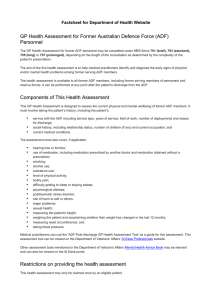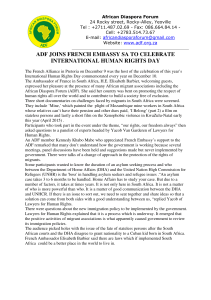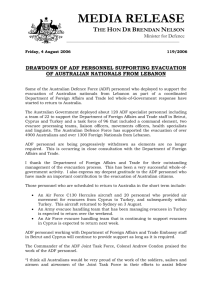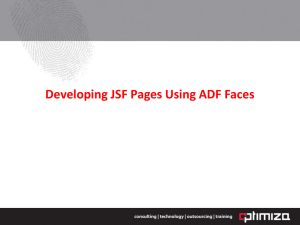Foreign Affairs, Defence and Trade Committee`s Inquiry into the
advertisement
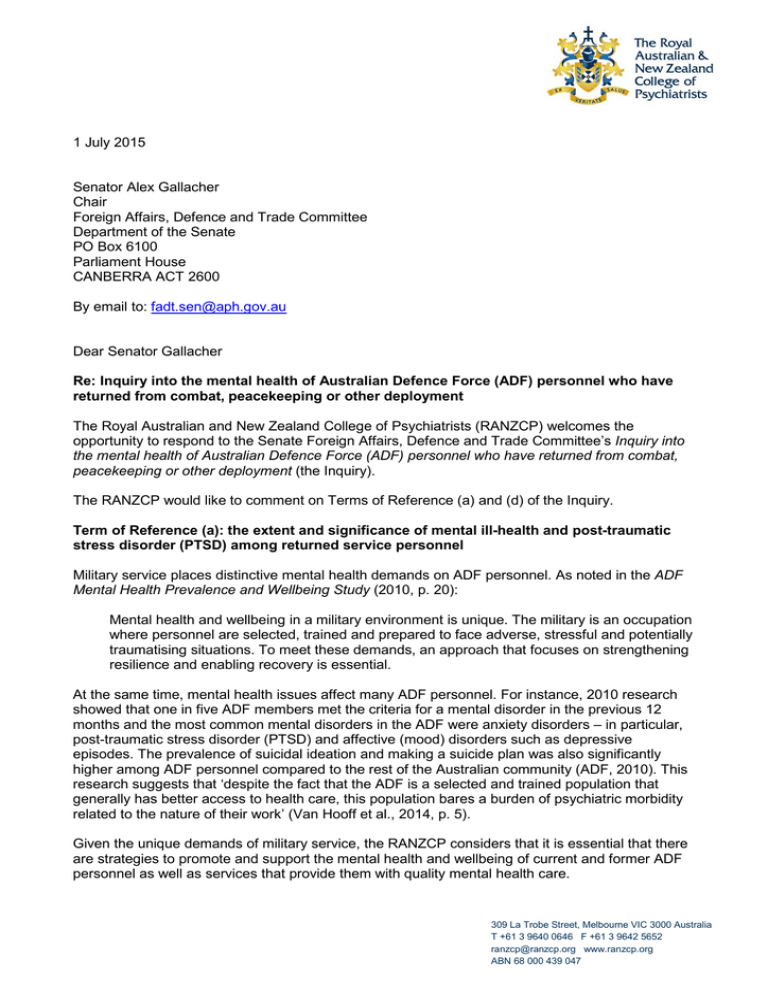
1 July 2015 Senator Alex Gallacher Chair Foreign Affairs, Defence and Trade Committee Department of the Senate PO Box 6100 Parliament House CANBERRA ACT 2600 By email to: fadt.sen@aph.gov.au Dear Senator Gallacher Re: Inquiry into the mental health of Australian Defence Force (ADF) personnel who have returned from combat, peacekeeping or other deployment The Royal Australian and New Zealand College of Psychiatrists (RANZCP) welcomes the opportunity to respond to the Senate Foreign Affairs, Defence and Trade Committee’s Inquiry into the mental health of Australian Defence Force (ADF) personnel who have returned from combat, peacekeeping or other deployment (the Inquiry). The RANZCP would like to comment on Terms of Reference (a) and (d) of the Inquiry. Term of Reference (a): the extent and significance of mental ill-health and post-traumatic stress disorder (PTSD) among returned service personnel Military service places distinctive mental health demands on ADF personnel. As noted in the ADF Mental Health Prevalence and Wellbeing Study (2010, p. 20): Mental health and wellbeing in a military environment is unique. The military is an occupation where personnel are selected, trained and prepared to face adverse, stressful and potentially traumatising situations. To meet these demands, an approach that focuses on strengthening resilience and enabling recovery is essential. At the same time, mental health issues affect many ADF personnel. For instance, 2010 research showed that one in five ADF members met the criteria for a mental disorder in the previous 12 months and the most common mental disorders in the ADF were anxiety disorders – in particular, post-traumatic stress disorder (PTSD) and affective (mood) disorders such as depressive episodes. The prevalence of suicidal ideation and making a suicide plan was also significantly higher among ADF personnel compared to the rest of the Australian community (ADF, 2010). This research suggests that ‘despite the fact that the ADF is a selected and trained population that generally has better access to health care, this population bares a burden of psychiatric morbidity related to the nature of their work’ (Van Hooff et al., 2014, p. 5). Given the unique demands of military service, the RANZCP considers that it is essential that there are strategies to promote and support the mental health and wellbeing of current and former ADF personnel as well as services that provide them with quality mental health care. 309 La Trobe Street, Melbourne VIC 3000 Australia T +61 3 9640 0646 F +61 3 9642 5652 ranzcp@ranzcp.org www.ranzcp.org ABN 68 000 439 047 Therefore, the RANZCP strongly supports the ADF’s increased focus on mental health in recent years as illustrated through the development of the 2011 ADF Mental Health and Wellbeing Strategy and ADF Mental Health and Wellbeing Action Plan (2012-2015). We also welcome the recently announced Transition and Wellbeing Research Program survey, which will be Australia’s largest investigation of the impact of military service on the health and wellbeing of serving and exserving ADF personnel. The RANZCP considers that PTSD, in particular, represents a significant and costly illness to military personnel, the families and Australian society. PTSD is associated with severe functional impairment (both occupational and social), high comorbidity with other psychiatric disorders, high medical comorbidity and / or reduced quality of life for the military personnel who have PTSD (Richardson, Frueh and Acierno, 2010). PTSD can also have a delayed onset as people who have coped at the time of stress exposure can become unwell many years later (Solomon and Mikulincer, 2006). Military personnel are confronted with a range of experiences that may contribute to PTSD. ADF research suggests that the most common traumatic event experienced by serving members is seeing someone badly injured or killed or unexpectedly seeing a dead body. In terms of developing PTSD, experiences such as witnessing atrocities or accidentally injuring or killing another person can pose the most significant risk (ADF, 2010). At the same time, the RANZCP believes it is important for the ADF to take a broad view of the causes of mental health issues affecting ADF personnel, including PTSD. The RANZCP also recently completed a review of clinical practice guidelines on PTSD after convening a panel of specialists to review and recommend suitable guidelines. While the panel concluded that all of the guidelines reviewed had utility and were appropriate for use, the RANZCP recommends the guidelines produced by Phoenix Australia (formerly the Australian Centre for Posttraumatic Mental Health) (2013) Australian guidelines for the treatment of adults with acute stress disorder and posttraumatic stress disorder as the ones most relevant for use in the Australian context. We refer the Committee to this document as a valuable source of information on how to understand and address the complex issues associated with diagnosing and treating PTSD, including in military personnel. Term of Reference (d): mental health evaluation and counselling services available to returned service personnel The stigma of mental illness is a major barrier for current and former ADF personnel seeking care for assistance with mental health problems. For instance, stigma attached to mental illness among military veterans may leads to denials and delays in care seeking, resulting in unnecessary suffering, self-medication, substance abuse and self-isolation (Sher and Braquehais, 2014). There is a particular perception among ADF personnel that asking for help with mental health issues may impact detrimentally on their military careers. This is illustrated by the ADF Mental Health Prevalence and Wellbeing Study, which interviewed up to 49% of ADF members and reported that within a 12 month period: 27.6% were concerned that reporting a mental disorder might result in being treated differently, 26.9% feared their career might be harmed and 36.9% stated the main barrier to them seeking help was their concern that doing so would reduce the likelihood of them being deployed (ADF, 2010). Therefore, the RANZCP welcomes the 11 June 2015 announcement that – following Phoenix Australia’s review of ADF mental health screening processes - the ADF will be introducing new mental health screening tools later this year. These include providing an anonymous online selfscreening mental health tool for serving members to access plus developing a mental health screening process, which will be used during routine medical appointments. While these are welcome initiatives, the RANZCP remains concerned that the issue of stigma means that ADF personnel may not utilise these resources or, if they do, will understate any issues with their mental health. We consider systematic screening to be particularly important in identifying mental health issues, particularly PTSD in military personnel who are or have been engaged in repeated high-risk exposures or who have had a recent deployment involving major events, which carries a significant risk of PTSD (Hicks, 2011). We, therefore, believe that it is crucial that the ADF implement an annual mental health survey during the time of ADF members’ service and, after their service, every two to three years. To maximise the effective treatment and diagnosis of PTSD, it is preferable that a mental health assessment of ADF personnel be undertaken face to face wherever possible. However, in circumstances where this is not possible, the RANZCP also strongly supports the idea of mental health services being provided and available to ADF personnel via video-link such as telepsychiatry. The RANZCP believes that telepsychiatry is an important option to provide access to mental health treatment and support for ADF personnel, who are often located in rural or remote areas. Telepsychiatry has been shown to be an effective means of improving rural and remote community access to specialist psychiatric resources (Lessing, 2001; Duckett, 2005). The RANZCP Telehealth Project also found that waiting times to access telehealth consultations are shorter compared to face-to-face consultations. The RANZCP also wishes to highlight the transition from health care provided by ADF to that funded by the Department of Veterans’ Affairs (DVA). While DVA has made it easier for ex ADF personnel to obtain treatment while they are still in the process of seeking compensation, there is often still a time lag for people moving from one service to another. The RANZCP encourages the ADF and DVA to continue to work collaboratively to improve transition procedures and processes in this context. If you would like to discuss any of the issues raised in the submission, please contact Rosie Forster, Senior Manager, Practice, Policy and Partnerships via rosie.forster@ranzcp.org or by phone on (03) 9601 4943. Yours sincerely Professor Malcom Hopwood President Ref: 4151 References Australian Defence Force (2010) Mental Health of the Australian Defence Force – 2010 ADF Mental Health Prevalence and Wellbeing Study Report. Available from: www.defence.gov.au/Health/DMH/MentalHealthReformProgram.asp#MHRP. Duckett, S (2005) Health workforce design for the 21st century. Australian Health Review 29(2): 9. Hicks, M H (2011) Mental health screening and coordination of care for soldiers deployed to Iraq and Afghanistan. American Journal of Psychiatry 168.4: 341-343. Lessing K (2001) Mental Health Telemedicine Programmes in Australia. Journal of Telemedicine and Telecare: 317-323. Richardson L, Frueh, B C and Acierno, R (2010) Prevalence estimates of combat-related posttraumatic stress disorder: critical review. Australian and New Zealand Journal of Psychiatry: 44:419. Sher, L and Braquehais, M D (2013) Suicidal behaviour in military veterans and health care professionals. Australian and New Zealand Journal of Psychiatry 48(6): 589. Solomon, Z and Mikulincer, M (2006) Trajectories of PTSD: a 20 year longitudinal study. American Journal of Psychiatry 163: 659-666. Van Hooff, M et al. (2014) The Australian Defence Force Mental Health Prevalence and Wellbeing Study: design and methods. European Journal of Psychotraumatology. 5: 10.3402/ejpt.v5.23950.
